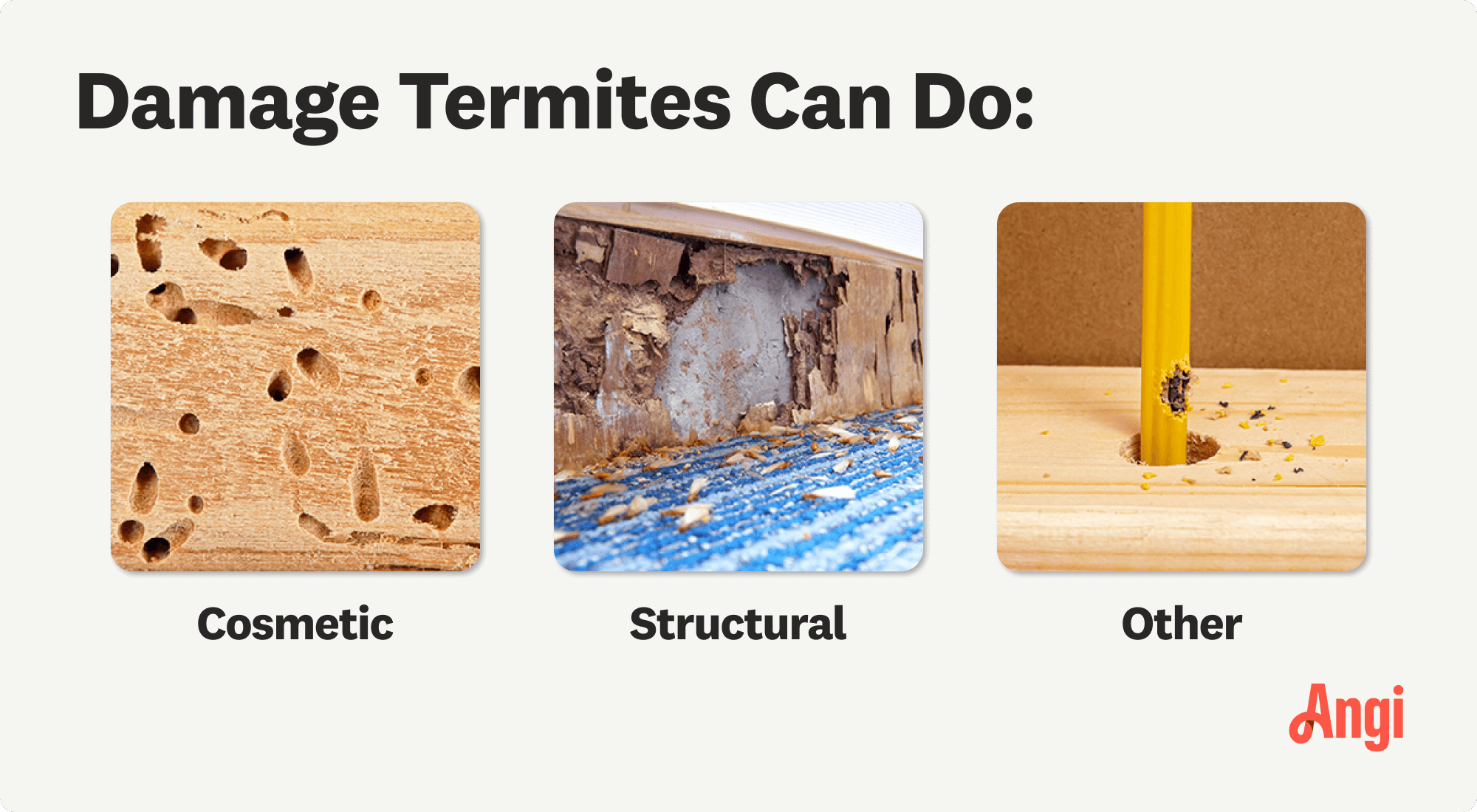
If you have a serious rodent problem, you may need to know the cost of hiring a rat exterminator. We can help you estimate costs in Washington, D.C.
Termites are hard to spot until they've done severe damage to your home, so regular inspections are a must


We recommend inspecting for termites at least once per year (ideally in early spring) or whenever you suspect an infestation.
Older houses in warm, humid areas are more likely to experience termite infestations.
Signs of termites include droppings, hollow-sounding wood, and wings left inside window frames.
Inspection typically costs between $50 and $250, while termite removal ranges from $230 to $1,000, depending on severity.
Termites can cause mold, mildew, wood damage, and structural issues, so hire a pro to remove them ASAP.
Wondering how often you should schedule a termite inspection? You should invest in termite inspections when you suspect activity or at least once per year, especially if you live in warm, moist climates like California, Hawaii, Texas, Louisiana, Alabama, Florida, and Georgia. If that’s the case, you should be even more vigilant about scheduling annual termite inspections.
Additionally, older homes are more likely to play host to these unwelcome guests. When you purchase a home, you may want to pay for a pest and termite inspection before making your final decision. You should hire a local termite control specialist to evaluate your home, diagnose the extent of infestation, and then carry out an eradication solution.

Most pest control experts recommend scheduling a termite inspection once per year, especially if you live in an older home or a high-risk area for termites. Annual termite inspections can ensure an infestation is caught and eliminated early and before it causes major damage to your home. Plus, they can implement prevention methods to keep wood-loving pests away. The best time to book a termite inspection is in the early spring. That’s when termites begin to swarm in the warm weather, making it easy for professional inspectors to identify signs of these hazardous pests.

Some signs of a termite inspection include:
Wings inside the window frames
Discarded wood pellets
Mud tubes near the foundation of your home
Hollow-sounding wood
Blistering wood (small bubbles that indicate moisture)
Bubbling paint
Tiny holes in the wall
Moisture in the floor that causes the tile to loosen
Crumbling damaged wood (look in the attic and other areas where you have better access to exposed wood)
If you notice any of these signs, call your local termite control pro ASAP.
Paying for a termite inspection is far better than ignoring a potential problem and spending a lot more later. The average cost of a termite inspection is between $50 and $250, depending on the location and size of your home.
Professional termite removal costs between $230 and $1,000, depending on the severity of the infestation. Smaller, more-localized treatments are less expensive but may not catch the entire nest of termites.
Unlike mosquitos, termites don’t pose a direct threat to humans. Most termites don’t bite. Termites are also not a known carrier or spreader of disease and do not inject venom when they do bite. Termites pose a significant threat to structures, though. Damage to a home not only decreases its value but could lead to other health issues caused by mold, mildew, and rotting wood.
One reason termites pose a significant threat is because they’re difficult to spot. They’re small, and they don’t congregate in common areas of your home. Termites spend a lot of time inside your walls, and that’s where they do real damage. You may not even know you have termites until they’ve caused extensive harm to the bones of your home.
It’s no surprise that many of the crucial components that make up the structure of your home are made of wood. Wood makes up portions of your home like the subflooring, framing, and support beams. Damage to these areas is expensive to repair and can make your home less structurally sound.
These bugs are annoying to deal with because getting rid of termites can be tougher than with other pests. If your home has a termite problem, you’ll need the help of a professional to eradicate them. Once you’ve removed the problem, you’ll need to assess the damage and plan for repairs.
The best thing you can do to protect your home is to take preventative measures. It’s easier to keep your home in good condition than to manage a problem later. Some things you can do to protect your home from many types of termites include:
Keeping all wood sources off the ground (wood stockpiles)
Keeping your foundation in good shape and preventing moisture from accumulating near the foundation
Never storing wood inside or against the outside of your home
Choosing an alternative to mulch in your landscaping
Trimming branches and tree overhangs away from the house
Regularly clearing out your gutters
From average costs to expert advice, get all the answers you need to get your job done.

If you have a serious rodent problem, you may need to know the cost of hiring a rat exterminator. We can help you estimate costs in Washington, D.C.

Whether you have bugs, bats, or rodents invading your home, you’ll want to contact an exterminator quickly. Find out how much pest control costs in Washington, D.C.

Budget for the cost of tick extermination services using our helpful cost guide.

No one wants wasps setting up shop in their yard but that doesn’t mean you should try to DIY their removal. Here are five reasons to leave wasp removal to the professionals.

Mouse droppings left in your home can harm your health. Learn how to clean mouse droppings and dispose of them safely using our complete guide.

Fleas and ticks are irritating and can cause health issues, especially for pets. Create a homemade flea and tick killer for your yard to keep your home safe.